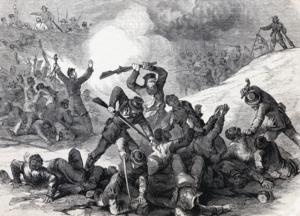Battle of Fort Pillow
| Battle of Fort Pillow | |||||||
|---|---|---|---|---|---|---|---|
| Part of the American Civil War | |||||||
 Caption in Frank Leslie's Illustrated Newspaper (New York), May 7, 1864- "The war in Tennessee: Confederate massacre of black Union troops after the surrender at Fort Pillow, April 12, 1864" |
|||||||
|
|||||||
| Belligerents | |||||||
|
|
|
||||||
| Commanders and leaders | |||||||
|
Lionel F. Booth † William F. Bradford † |
Nathan Bedford Forrest James R. Chalmers |
||||||
| Units involved | |||||||
|
Fort Pillow garrison 2nd U.S. Artillery (C) 6th U.S. Artillery (C) 14th Tenn Cavalry U.S. |
1st Division, Forrest's Cavalry Corps | ||||||
| Strength | |||||||
| 600 | 1,500–2,500 | ||||||
| Casualties and losses | |||||||
| 182 killed, drowned and missing | 100 total 14 killed 86 wounded |
||||||
The Battle of Fort Pillow, also known as the Fort Pillow massacre, was fought on April 12, 1864, at Fort Pillow on the Mississippi River in Henning, Tennessee, during the American Civil War. The battle ended with a massacre of Union troops (most of them African American soldiers) attempting to surrender, by soldiers under the command of Confederate Major General Nathan Bedford Forrest. Military historian David J. Eicher concluded, "Fort Pillow marked one of the bleakest, saddest events of American military history."
The deployment of black men as U.S. soldiers by the Union, combined with Abraham Lincoln's issuing of the Emancipation Proclamation, profoundly angered the Confederacy, with the Confederates calling it uncivilized. In response the Confederacy in May 1863 passed a law demanding that black U.S. soldiers captured while fighting against the Confederacy would be tried as slave insurrectionists in civil courts; a capital offense with automatic sentence of death. The law stated that the Confederates should commit "full and ample retaliation" against such persons.
Fort Pillow, on the Mississippi River 40 mi (64 km) north of Memphis, was built by Confederate Brigadier General Gideon Johnson Pillow in early 1862 and was used by both sides during the war. With the fall of New Madrid and Island No. 10 to Union forces, Confederate troops evacuated Fort Pillow on June 4, in order to avoid being cut off from the rest of the Confederate army. Union forces occupied Fort Pillow on June 6 and used it to protect the river approach to Memphis.
...
Wikipedia
